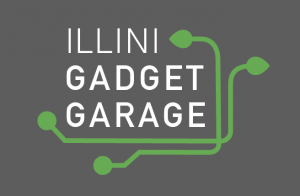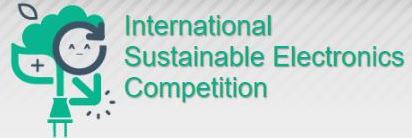For more information on any of the following projects, please contact Joy Scrogum, ISTC Sustainability Specialist.
Illini Gadget Garage
The Illini Gadget Garage is a collaborative repair center for student and staff owned electronic devices, in order to:
- extend the useful life of products
- provide experiential learning for student through associated classes, volunteering, and participation in the iFixit Technical Writing Project; and
- empower people to see do-it-yourself repair as a viable option for addressing minor damage and performance issues

The Illini Gadget Garage (IGG) was launched by the Illinois Sustainable Technology Center (ISTC) in collaboration with the iSchool at Illinois and the UI School of Art + Design with seed funding from the UI Student Sustainability Committee. ISTC coordinated the project from its inception until December 2018. In addition to the SSC seed funding, the project was support by donations from individuals and corporations to the UI Foundation’s Sustainable Electronics Initiative Support Fund (see http://illini-gadget-garage.istc.illinois.edu/sponsors/).
As of January 2019, the Center for Innovation in Teaching and Learning (CITL) is coordinating the IGG.
See the Illini Gadget Garage project web site for more information.
International E-Waste Design Competition /Sustainable Electronics Competition
During the Spring 2009 semester, University of Illinois at Urbana-Champaign (UIUC) students were challenged to create appealing, useful products from e-waste. Participants were encouraged to enroll in a School of Art and Design course on sustainability and e-waste issues (ARTD 391/591) taught by industrial design Professor William Bullock. Students in this class conducted an e-waste collection on campus to gather unused CPUs, monitors, keyboards, mice, printers, scanners and cell phones as fodder for design competition projects. Educational goals for the students included learning about ways to re-use e-waste for new and productive means, exploring ideas for how to address e-waste problems, and contributing to the body of knowledge that advances the practice of environmentally responsible product design for current and future computing technology products. Industry experts came to the UI campus to judge student project prototypes, displayed on the Quad. The name of this local event was the “Sustainable E-Waste Design Competition,” and categories included “Designer/Artist” and “Technical/Geek.”
In 2010, the competition expanded to a global scale where applicants were asked to submit videos of their entries via YouTube. While the competition had expanded to an international scale, Professor Bullock’s class participated in the local Champaign County Electronics Recycling Drive, and the class received donated electronics from Advanced Technology Recycling, which were used by the students in their project entries for the e-waste competition. The competition name changed to the “International E-Waste Design Competition,” and the jury continued to be composed of experts from industry and academia throughout the competition’s run, with entries evaluated via an online system and a final juror conference call to discuss ratings and finalize the winners. The “Designer/Artist” and “Technical/Geek” categories were replaced in 2011 by “Prevention” (projects to reduce generation of e-waste in the first place) and “Reuse” (projects incorporating electronic scrap into new and useful products).

The competition continued to evolve, and lasted through 2013. By that point, it was known as the “International Sustainable Electronics Competition,” and the categories had shifted to reflect entries that represented “Product” and “Non-Product” concepts. A representative of the US EPA observed the jury process, and used her observations to shape the EPA Sustainable Materials Management (SMM) Electronics Challenge.
Archives of each year’s competition website will be available soon within the ISTC IDEALS collection: https://www.ideals.illinois.edu/handle/2142/682. In the meantime, you can see winning videos from 2010-2013 (the years the competition was an online international event) on the SEI YouTube Channel, https://www.youtube.com/user/SEIatISTC.
ENG/TE 498–“Sustainable Technology: Environmental and Social Impacts of Innovations.”
Taught Spring 2014. Dr. Brian Lilly of the Technology Entrepreneur Center was the professor of record for this course, developed and taught by SEI staff members Joy Scrogum and Kirsten Walker. The class introduced the environmental and social impacts associated with technology at each stage of the product life cycle (design, manufacture, consumption, and disposal/recovery). Electronic products were used as a special case study and provided the framework for discussion of complex legal, economic, social, and environmental considerations. For their final course project, student groups could choose to prepare a mock entry for the then defunct International Sustainable Electronics Competition or to work on developing an online repair guide via the iFixit Technical Writing Project. (Note: UIUC participation in this project continued through the Illini Gadget Garage. See https://illini-gadget-garage.istc.illinois.edu/ifixit-student-guides/ for links to guides developed as part of this course and through Illini Gadget Garage efforts.)
ISTC Sustainable Electronics Seminar Series
In Fall 2012, ISTC hosted a series of webinars focused on sustainable electronics issues, featuring research and perspectives from members of the University of Illinois community and experts from around the country. For more information and webinar archives, see the ISTC website.
The final webinar in the Fall 2012 series was the International E-Waste Video Festival, at which the winners of the 2012 International E-Waste Design Competition were announced.
More past project summaries coming soon.
